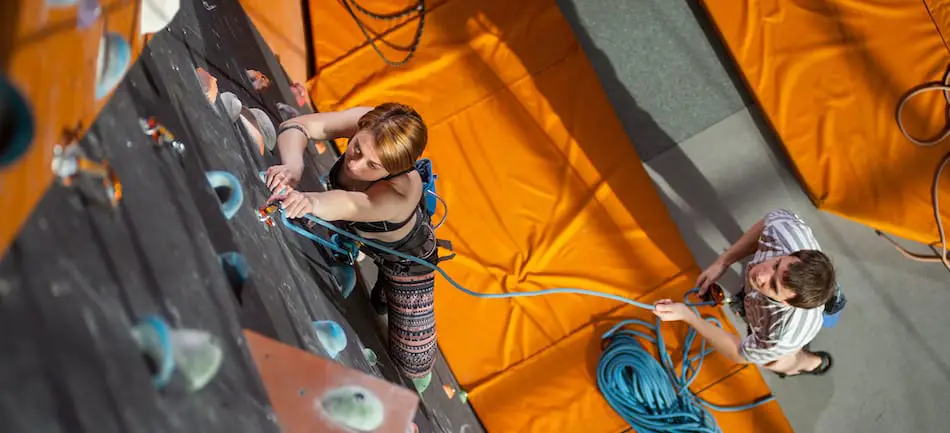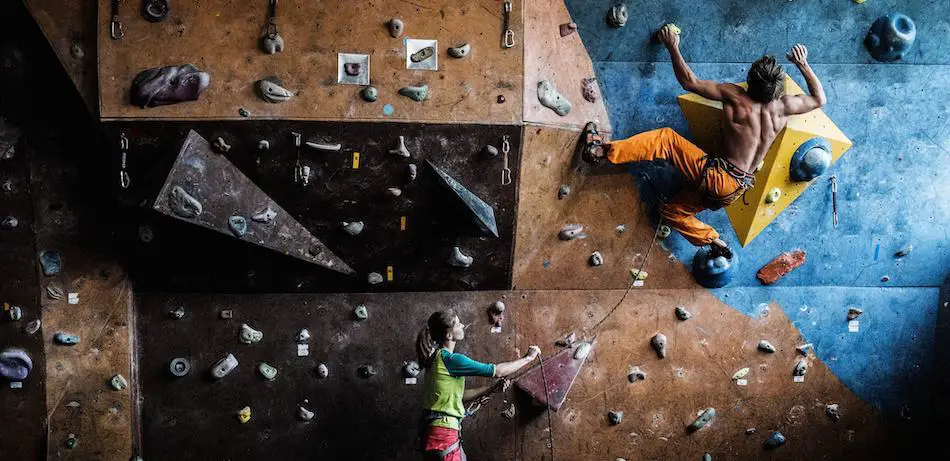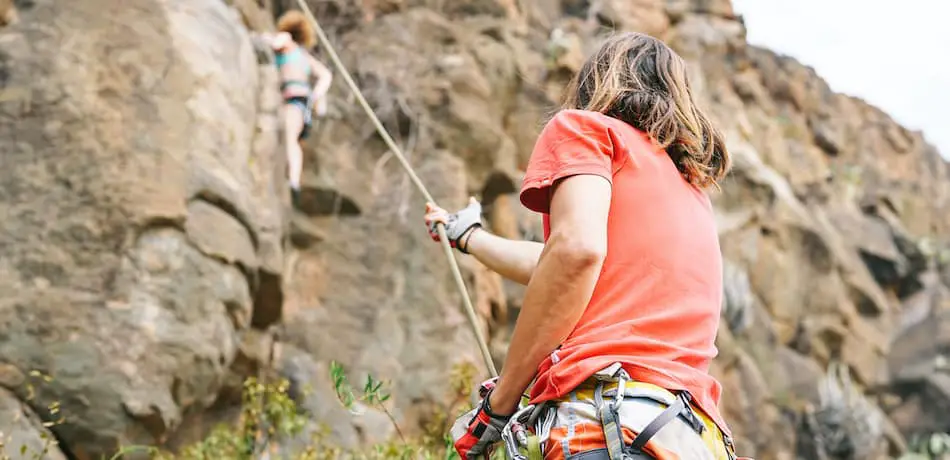
Leading climbing is a big jump for many people to make, but it can also look pretty dangerous. I’ve written the following guide to teach you everything you need to know about the risks!
So, is lead climbing dangerous? Lead climbing is one of the most dangerous forms of rock climbing, and requires a skilled climber/belayer to be performed safely.
Because of the increased fall distance and all of the risks associated with it, lead climbing is probably the riskiest activity that most climbers will do. There’s a decent risk of getting moderately injured, and a real (but manageable) risk of getting seriously injured. To avoid this, you should make sure to only lead climb with highly experienced belayers who have been taught by a trained professional.
Dangers of Lead Climbing

So, what are some of the dangers of lead climbing? Most of them, obviously, have to do with what happens when you fall. Because of the way your rope is set up, you can fall anywhere from 5 to 30 feet when lead climbing, depending on your clipping position and how tight the rope is.
Whenever you’re falling that far, there’s going to be some risk involved. I’ve summarized a few of the most common ones below.
Pendulum Swings
A pendulum swing is when your rope is too tight when you fall, which causes you to ‘pendulum’ when you fall, swinging back into the wall with incredible speed. This is obviously dangerous, because you’re headed towards a very hard surface at high speeds.
If you don’t get your feet out in front of you to cushion the blow, you could slam into the rock pretty hard. This can cause concussions, bruising, or even broken bones if you do it wrong. There’s one story about a fellow swinging in so hard that he shattered his kneecap.
Avoiding pendulum swings is a team effort between you and your belayer. You should focus on overhung terrain and avoid getting too high above your clip until you’re more comfortable controlling your swing.
Your belayer needs to manage the right amount of slack in the rope to catch you when you do fall so that they can cushion you. If they hold the rope too tight, it makes the pendulum motion worse.
This is part of the reason that having a competent and experience belayer while lead climbing is so important.
Danger feet (Toe Tucking)
Danger feet are one of the worst mistakes you can make when lead climbing, and it’s one of the most common ones that I see beginners make. This is when your toe, foot, or entire leg goes between the rock and your rope.
Now, this may not sound like a big deal, but check out the above video to see what happens when you fall with a danger foot in place. Your leg catches on the rope, spinning you upside-down and often twisting you in weird positions.
This makes it basically impossible to control the fall, and it means that you’re far more likely to swing head-first into the rock.
Avoiding toe tucking is a matter of experience. At first it can be difficult, and it will probably mess with your footwork a little bit, but with some training and intentionally thinking, you’ll get used to it.
The important thing to remember is that your leg should never be between the rope and the wall. You want to try to keep it between your legs, but that’s not always possible; in lieu of that, just make sure it’s never behind the rope.
Your belayer also has a hand in this. They need to be paying attention when you’re leading and warning you any time you tuck your feet. With your belayer calling it out for you, it’s a lot easier to avoid committing this mistake, and you’re a lot more likely to stay safe.
Decking
Decking is the climbing word for when you fall and hit the ground. This leads to an array of injuries from broken bones to spinal fractures, and it should be avoided at all costs.
You’re at risk of decking any time the distance from your to your last bolt is greater than the distance from your last bolt to the ground. Basically, this means that if you fall, you’ll hit the ground before the rope has a chance to catch you.
Usually, this only happens on the first bolt. Once you’ve clipped the second bolt on your route, you’re mostly safe, and you can let out a little sigh of relief.
Until then, though, you need to be climbing extra careful, and your belayer should be spotting you. Spotting a lead climbing involves keeping your hands up and staying below them until they’re out of decking danger.
It’s important to note that your spotter isn’t necessarily trying to catch you, especially if they’re smaller than you. Rather, their job is to make sure that you land feet-first on the ground rather than on your back or neck.
Another thing you can do to avoid decking is to use a stick clip. Stick clips are a wonderful invention that every climber should use; they allow you to clip the first (or even second) bolt on a route from the ground, removing the chance that you deck. For something that costs only $40, stick clips can save you from some pretty nasty injuries.
Belayer Risks

Your belayer is important all the time, but they’re especially important when lead climbing. They don’t only need to catch you when you fall; they need to spot you, manage your slack, call out and danger feet, and be actively involved in the climb.
If they mess up, you’re at a serious risk of falling from tens of feet and hitting the ground; this can lead to a life changing injury.
Like I’ve said many times already, you should only be lead climbing with experienced belayers who have been taught by certified instructors. I’ve tried to self-teach a couple of my friends before, and it’s been scary climbing with them.
I know finding partners can be hard, but you need to make sure that you don’t cut corners here. It could cost you your safety, and maybe also your life.
Clipping Risks
Finally, there are clipping risks to be aware of. There are two main things to look out for:
Back Clipping
Back clipping is when you flip the rope around to clip it (the above video demonstrates this better than I can with words). This means that the rope could actually pull open the carabiner when you fall, increasing your fall distance and the chance of decking.
As always, your belayer should be looking out for you and calling out any back clips.
Z-Clipping
Z Clipping is when you get your rope crossed and clip above or below your last clip (again, this video will explain it better). Z clipping messes with the load distribution of your rope and can damage equipment, as well as furthering your fall distance.
Staying Safe While Lead Climbing

So, now that we’ve covered the dangers, how can you stay safe while lead climbing?
Really, the most important thing is to make sure that both you and your belayer are certified by a professional. Learn the moves on easy terrain, practice a few falls with a backup belay, and don’t push your limits until both of you are comfortable.
Even once that’s taken care of, though, there are a couple more things you can do to increase how safe you are:
Use a Gri Gri
Really, there’s no excuse for not using a gri gri as your main belay device. The gri gri is so good, and it’s been around for so long, that it’s become an established part of modern climbing culture. Everyone knows how to use one, and just about everyone owns one.
I know that gri gri’s are expensive, which could be a barrier for some, but I would really recommend saving up some money to buy one. As someone who recently made the switch from an ATC, let me tell you: I feel a lot better as both a climber and a belayer when the rope is running through a gri gri.
Work Your Way Up
As much fun as lead climbing is, and as tempting as it can be to immediately throw yourself at the hardest route you can climb, taking it slow is the way to go.
Although the routes may be the same, there’s a lot of new skills that you need to learn when you switch to lead climbing. Your footwork, clipping, and decision-making are all different. Falling is a skill of its own, and you need to learn how to position yourself for when it happens.
Because of this, I would say that you should spend about a month or two slowly integrating lead climbing into your climbing routine, instead of jumping right off the deep end.
